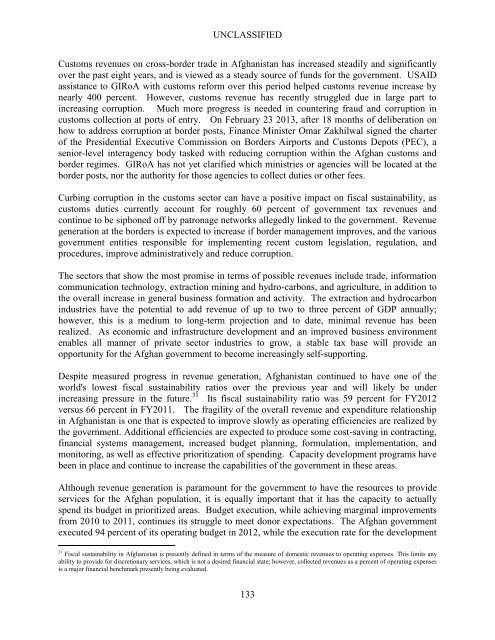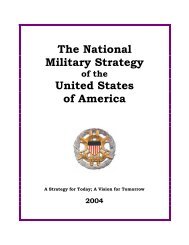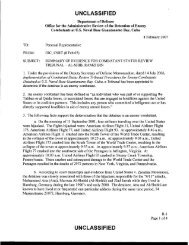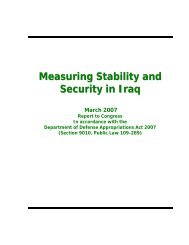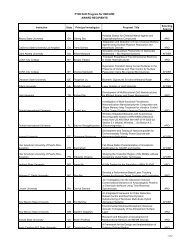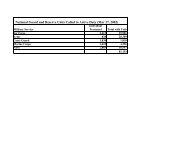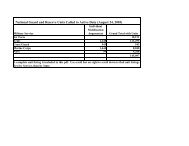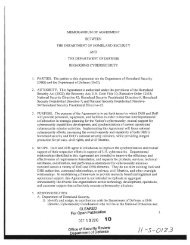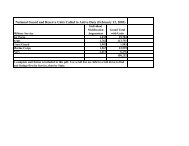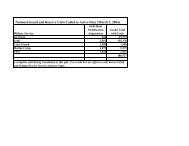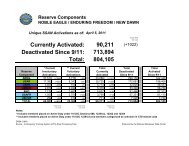Report - United States Department of Defense
Report - United States Department of Defense
Report - United States Department of Defense
Create successful ePaper yourself
Turn your PDF publications into a flip-book with our unique Google optimized e-Paper software.
UNCLASSIFIED<br />
Customs revenues on cross-border trade in Afghanistan has increased steadily and significantly<br />
over the past eight years, and is viewed as a steady source <strong>of</strong> funds for the government. USAID<br />
assistance to GIRoA with customs reform over this period helped customs revenue increase by<br />
nearly 400 percent. However, customs revenue has recently struggled due in large part to<br />
increasing corruption. Much more progress is needed in countering fraud and corruption in<br />
customs collection at ports <strong>of</strong> entry. On February 23 2013, after 18 months <strong>of</strong> deliberation on<br />
how to address corruption at border posts, Finance Minister Omar Zakhilwal signed the charter<br />
<strong>of</strong> the Presidential Executive Commission on Borders Airports and Customs Depots (PEC), a<br />
senior-level interagency body tasked with reducing corruption within the Afghan customs and<br />
border regimes. GIRoA has not yet clarified which ministries or agencies will be located at the<br />
border posts, nor the authority for those agencies to collect duties or other fees.<br />
Curbing corruption in the customs sector can have a positive impact on fiscal sustainability, as<br />
customs duties currently account for roughly 60 percent <strong>of</strong> government tax revenues and<br />
continue to be siphoned <strong>of</strong>f by patronage networks allegedly linked to the government. Revenue<br />
generation at the borders is expected to increase if border management improves, and the various<br />
government entities responsible for implementing recent custom legislation, regulation, and<br />
procedures, improve administratively and reduce corruption.<br />
The sectors that show the most promise in terms <strong>of</strong> possible revenues include trade, information<br />
communication technology, extraction mining and hydro-carbons, and agriculture, in addition to<br />
the overall increase in general business formation and activity. The extraction and hydrocarbon<br />
industries have the potential to add revenue <strong>of</strong> up to two to three percent <strong>of</strong> GDP annually;<br />
however, this is a medium to long-term projection and to date, minimal revenue has been<br />
realized. As economic and infrastructure development and an improved business environment<br />
enables all manner <strong>of</strong> private sector industries to grow, a stable tax base will provide an<br />
opportunity for the Afghan government to become increasingly self-supporting.<br />
Despite measured progress in revenue generation, Afghanistan continued to have one <strong>of</strong> the<br />
world's lowest fiscal sustainability ratios over the previous year and will likely be under<br />
increasing pressure in the future. 31 Its fiscal sustainability ratio was 59 percent for FY2012<br />
versus 66 percent in FY2011. The fragility <strong>of</strong> the overall revenue and expenditure relationship<br />
in Afghanistan is one that is expected to improve slowly as operating efficiencies are realized by<br />
the government. Additional efficiencies are expected to produce some cost-saving in contracting,<br />
financial systems management, increased budget planning, formulation, implementation, and<br />
monitoring, as well as effective prioritization <strong>of</strong> spending. Capacity development programs have<br />
been in place and continue to increase the capabilities <strong>of</strong> the government in these areas.<br />
Although revenue generation is paramount for the government to have the resources to provide<br />
services for the Afghan population, it is equally important that it has the capacity to actually<br />
spend its budget in prioritized areas. Budget execution, while achieving marginal improvements<br />
from 2010 to 2011, continues its struggle to meet donor expectations. The Afghan government<br />
executed 94 percent <strong>of</strong> its operating budget in 2012, while the execution rate for the development<br />
31 Fiscal sustainability in Afghanistan is presently defined in terms <strong>of</strong> the measure <strong>of</strong> domestic revenues to operating expenses. This limits any<br />
ability to provide for discretionary services, which is not a desired financial state; however, collected revenues as a percent <strong>of</strong> operating expenses<br />
is a major financial benchmark presently being evaluated.<br />
133


